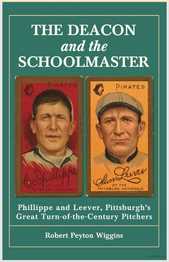The Deacon and the Schoolmaster: Phillippe and Leever, Pittsburgh's Great Turn-of-the-Century Pitchers - Robert Peyton Wiggins

Leever didn't linger in Maysville very long before he jumped to the team from Norwood. a suburb of Cincinnati. The captain of the Norwood Maroons was future major league infielder Norman "Kid" Elberfield, who was referred to by one biographer as "the dirtiest, scrappiest, most pestiferous, most cantankerous, most rambunctious ball player that ever stood in spikes."
Leever returned to Maysville on July10 to pitch against his former club. He went the distance and despite striking out 13, lost, 11 to 10. The Maysville newspaper called the Norwoods "a set of gentlemen who don't know how to play the game" and noted that "Sammy" Leever "was the whole club" as he hit two singles and a triple in addition to the mound duties.
Leever seriously wrenched his knee on a play at second base during the Maysville game and went home to recuperate. A few days later it was suggested that he was healing slowly and it would be weeks before he would be able to rejoin his team.
Leever would not play another game with the Norwoods in 1895. The day he sent a letter to the manager of the Maroons explaining that he was ill and would not be able to pitch for at least a month. Sam pitched for New Richmond in a game against a team from Bativia, Ohio.'° Before that game he met Billy Earle, a journeyman catcher for several major league clubs (including Pittsburgh 1892-93), who would claim credit for "discovering" Leever.
"I ran up from Clarksville, Tennessee, to catch a game for New Richmond in a little Clermont County town," recalled Earle. "We played on a diamond laid out in a cornfield and I caught Leever for the first time. He was a country schoolteacher. He looked so good to me I coaxed him to go to Clarksville with me, and I paid his fare. I took Norman Elberfield at the same time."
Leever returned to Maysville on July10 to pitch against his former club. He went the distance and despite striking out 13, lost, 11 to 10. The Maysville newspaper called the Norwoods "a set of gentlemen who don't know how to play the game" and noted that "Sammy" Leever "was the whole club" as he hit two singles and a triple in addition to the mound duties.
Leever seriously wrenched his knee on a play at second base during the Maysville game and went home to recuperate. A few days later it was suggested that he was healing slowly and it would be weeks before he would be able to rejoin his team.
Leever would not play another game with the Norwoods in 1895. The day he sent a letter to the manager of the Maroons explaining that he was ill and would not be able to pitch for at least a month. Sam pitched for New Richmond in a game against a team from Bativia, Ohio.'° Before that game he met Billy Earle, a journeyman catcher for several major league clubs (including Pittsburgh 1892-93), who would claim credit for "discovering" Leever.
"I ran up from Clarksville, Tennessee, to catch a game for New Richmond in a little Clermont County town," recalled Earle. "We played on a diamond laid out in a cornfield and I caught Leever for the first time. He was a country schoolteacher. He looked so good to me I coaxed him to go to Clarksville with me, and I paid his fare. I took Norman Elberfield at the same time."
The Deacon and the Schoolmaster: Phillippe and Leever, Pittsburgh's Great Turn-of-the-Century Pitchers
Robert Peyton Wiggins
McFarland, Aug 12, 2011 - 296 pages
Among the great pitchers in baseball history, Charles "Deacon" Phillippe and Samuel "The Schoolmaster" Leever are hardly household names. But during the first decade of the twentieth century, these two Pittsburgh Pirates were among the most celebrated pitchers in the majors. From 1900 through 1906, they posted a combined record of 261 victories against 131 losses for a win-loss percentage of .666. During the years Deacon and the Schoolmaster pitched together, the Pirates never finished out of the first division, won four National League pennants, and came in second four times. Without flamboyance or controversy to color their legacy, their fame faded quickly after their playing days. But they remain among the most important players in the history of the club.
Robert Peyton Wiggins
McFarland, Aug 12, 2011 - 296 pages
Among the great pitchers in baseball history, Charles "Deacon" Phillippe and Samuel "The Schoolmaster" Leever are hardly household names. But during the first decade of the twentieth century, these two Pittsburgh Pirates were among the most celebrated pitchers in the majors. From 1900 through 1906, they posted a combined record of 261 victories against 131 losses for a win-loss percentage of .666. During the years Deacon and the Schoolmaster pitched together, the Pirates never finished out of the first division, won four National League pennants, and came in second four times. Without flamboyance or controversy to color their legacy, their fame faded quickly after their playing days. But they remain among the most important players in the history of the club.



